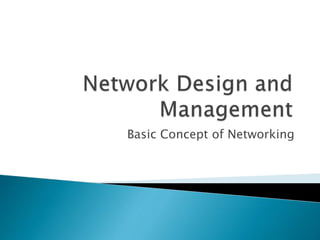
Basic concept of networking
- 1. Basic Concept of Networking
- 2. Enable communication between network applications on different end-points – End-points? computers, cell phones…. – Application? Web, Peer to Peer, Streaming video, IM – Communication? transfer bits or information across a “network”
- 3. A collection of autonomous computers interconnected by a single technology. Interconnected means they are able to exchange information. Copper wire, fiber optics, microwaves, infrared and communication satellites can be used for connection.
- 4. • Computer Networks: A computer network is an interconnected collection of autonomous computers able to exchange information. A computer network usually require users to explicitly login onto one machine, explicitly submit jobs remotely, explicitly move files/data around the network.
- 5. • Distributed System In distributed system a collection of independent computers appears to its user as a single coherent system where a layer of software on top of the operating system. The existence of multiple autonomous computers in a computer network is transparent to the user. The operating system automatically allocates jobs to processors, moves files among various computers without explicit user intervention.
- 6. Thus, the distinction between a network and a distributed system lies with software rather than hardware.
- 7. Broadly speaking, there are two types of transmission technology: 1. Broadcast link 2. Point-to-point links
- 15. The physical layer deals with the physical characteristics of the transmission medium. It defines the electrical, mechanical, procedural, and functional specifications for activating, maintaining, and deactivating the physical link between end systems. Such characteristics as voltage levels, timing of voltage changes, physical data rates, maximum transmission distances, physical connectors, and other similar attributes are defined by physical layer specifications. Examples :- EIA/TIA-232, RJ45, NRZ.
- 16. Physical Layer: The Physical layer is responsible for movement of individual bits from one hop (node) to the next
- 17. The data link layer provides access to the networking media and physical transmission across the media and this enables the data to locate its intended destination on a network. The data link layer provides reliable transit of data across a physical link by using the Media Access Control (MAC) addresses. The data link layer uses the MAC address to define a hardware or data link address in order for multiple stations to share the same medium and still uniquely identify each other. Concerned with network topology, network access, error notification, ordered delivery of frames, and flow control. Examples :- Ethernet, Frame Relay, FDDI.
- 18. Data Link Layer: The data link layer is responsible for moving frames from one hop (node) to the next.
- 20. Defines end-to-end delivery of packets. Defines logical addressing so that any endpoint can be identified. Defines how routing works and how routes are learned so that the packets can be delivered. The network layer also defines how to fragment a packet into smaller packets to accommodate different media. Routers operate at Layer 3. Examples :- IP, IPX, AppleTalk.
- 21. Network Layer: The network layer is responsible for the delivery of individual packets from the source host to the destination host.
- 23. The transport layer regulates information flow to ensure end-to- end connectivity between host applications reliably and accurately. The transport layer segments data from the sending host's system and reassembles the data into a data stream on the receiving host's system. The boundary between the transport layer and the session layer can be thought of as the boundary between application protocols and data-flow protocols. Whereas the application, presentation, and session layers are concerned with application issues, the lower four layers are concerned with data transport issues. Layer 4 protocols include TCP (Transmission Control Protocol) and UDP (User Datagram Protocol).
- 24. Transport Layer: The transport layer is responsible for the delivery of a message from one process to another.
- 26. The session layer defines how to start, control and end conversations (called sessions) between applications. This includes the control and management of multiple bi- directional messages using dialogue control. It also synchronizes dialogue between two hosts' presentation layers and manages their data exchange. The session layer offers provisions for efficient data transfer. Examples :- SQL, ASP(AppleTalk Session Protocol).
- 27. Session Layer: The session layer is responsible for dialog control and synchronization.
- 28. The presentation layer ensures that the information that the application layer of one system sends out is readable by the application layer of another system. If necessary, the presentation layer translates between multiple data formats by using a common format. Provides encryption and compression of data. Examples :- JPEG, MPEG, ASCII, EBCDIC, HTML.
- 29. The Presentation Layer: The presentation layer is responsible for translation, compression, and encryption.
- 30. The application layer is the OSI layer that is closest to the user. It provides network services to the user’s applications. It differs from the other layers in that it does not provide services to any other OSI layer, but rather, only to applications outside the OSI model. Examples of such applications are spreadsheet programs, word processing programs, and bank terminal programs. The application layer establishes the availability of intended communication partners, synchronizes and establishes agreement on procedures for error recovery and control of data integrity.
- 31. The application layer: The application layer is responsible for providing services to the users.